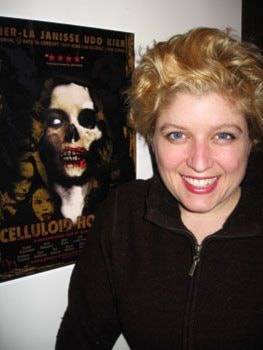Ana Rewakowicz wears a dress that can kill her.
But so far, the Montreal-based artist has been able to outsmart her work.
Called the Sleeping-Bag Dress, the inflatable outfit transforms from frock to tent in a matter of minutes.
All it needs is air.
But that’s the tricky part.
Stay too long in the translucent sleeping tube and the oxygen level begins to dip dangerously low.
“If you’re not careful it can become the suicidal dress,” said Rewakowicz in a slight Polish accent.
“You could go in there and go to sleep forever.”
Friday afternoon, Rewakowicz was readying the Ted Harrison Artist Retreat for her upcoming weekend workshop.
The focus was inflatables.
“Maybe we’ll make a big (blow-up) staircase from this porch,” she said standing on the balcony admiring Crag Lake.
“But it might be more of a slide.”
Rewakowicz became intrigued by inflatables 10 years ago, after working with latex.
“I was interested in the body’s sensory experiences,” she said.
“Especially through touch and skin, which is the largest organ in the body.”
Rewakowicz found a way to create latex goose bumps, exploring “that contradictory state where you can be cold and uncomfortable or just really excited.”
At one point she ended up blowing up the latex into a simple inflatable pillow.
And she’s never looked back.
In keeping with the latex-as-skin theme, Rewakowicz made some colourful inflatable suits.
With air pumps strapped on their feet, the wearers blow up their inflatable outfits with every step.
“Eventually the suits gets so tight the people can’t bend their legs or move,” said Rewakowicz.
But after standing still for a moment, the suits start losing air and the wearers can walk again.
The sleeping-bag dress is a little more elegant.
Instead of clomping around with pumps on her feet, Rewakowicz relies on solar power to blow up the tent.
The solar panel runs down the back of the dress as a striking fashion statement.
Trouble is, when the sun is shining from the front, Rewakowicz has to walk backwards to keep a charge.
“I’m interested in sustainable energy,” she said, citing composting toilets that create enough gas to cook with.
“And (the dress) is like animals that carry their houses on their back, crabs or snails — it fits with our modern notions of mobility.
“You don’t have to worry about overbooked hotels or campgrounds,” she added with a laugh.
Rewakowicz is also working on the design for a parachute dress.
“My ideas often involve a lot of research,” she said, pulling up plans on her computer for an inflatable footbridge designed to cross the harbour in Helsinki, Finland.
The bridge didn’t fly and instead ended up floating on the water like a giant sea snake.
Rewakowicz spent her time at the Ted Harrison Retreat researching mist.
She has an upcoming outdoor exhibit in Kitchener, Ontario, that involves yellow raincoats, red umbrellas and the white stuff.
The installation was created before in an empty Montreal swimming pool, but once outdoors Rewakowicz will need higher quality mist to get the same effect, she said.
“I’m researching how to increase water pressure and teaching myself a lot about electronics,” she said.
The only inflatables Rewakowicz made while in the North were created during the weekend workshop.
Apparently, there’s a large blow-up jellyfish floating around Whitehorse.
Rewakowicz pulled up a slide on her computer of a small off-white cube sitting in a Prairie landscape.
“That was a room from one of my Montreal apartments,” she said.
Rewakowicz covered the room in rubber latex and then peeled the whole thing off in one piece.
She added an outside skin and blew it up, creating a latex copy of the furnished room, complete with ceiling moldings.
Viewers could walk around in the inflatable room. But it’s hard to stay upright, said Rewakowicz.
And it’s not like one of those bouncy castles, she warned.
“If you fall you hit the ground hard.”
Rewakowicz and her room travelled from coast to coast, with the artist sleeping in it every night.
“I had to get up every few hours to re-inflate it,” she said.
Since being in the Yukon, Rewakowicz’s love of landscape has grown.
“I like to think about people and space,” she said.
“And the body as space.
“In a sense, the body is the perfect inflatable.”
